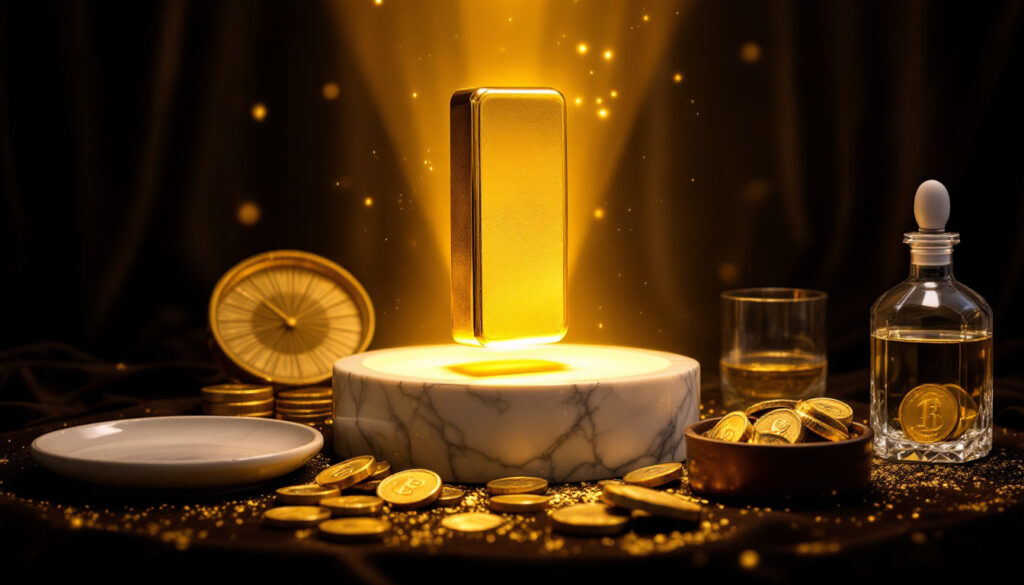How to Tell if Gold is Real: 8 Proven DIY Testing Methods
In a world where gold maintains its status as one of the most valuable commodities, knowing how to verify its authenticity has become increasingly important. With counterfeit gold products flooding the market, these eight reliable DIY testing methods can help you determine if your gold is genuine or fake.
Understanding the Value of Gold Authentication
The Importance of Verifying Gold Authenticity
Gold continues to be one of the most sought-after precious metals globally, treasured both for jewelry and investment purposes. With gold prices consistently high, the incentive for counterfeiting has never been greater, making verification an essential skill for buyers and sellers alike.
According to industry experts, approximately 20% of gold items found in pawnshops fail authenticity tests, highlighting the prevalence of counterfeit gold in the market. This sobering statistic underscores why proper authentication methods are critical.
Common Gold Counterfeiting Techniques
Counterfeiters have developed increasingly sophisticated methods to create fake gold items. These include gold plating (applying a thin layer of gold over base metals), gold filling (bonding a thicker layer of gold to base metals), and using tungsten—which has nearly identical density to gold—as a core material.
“Counterfeiters increasingly use tungsten cores with gold plating,” warns Jeff Moriarty, a jewelry industry expert. “This makes detection particularly challenging because tungsten’s density (19.25 g/cm³) is remarkably close to gold’s 19.32 g/cm³, allowing these counterfeits to pass basic density tests.”
Recent reports indicate that in 2023, authorities seized $2 million worth of counterfeit gold bars in Miami that contained tungsten cores, demonstrating the sophisticated nature of modern counterfeiting operations.
What Makes Gold Unique?
Physical Properties of Pure Gold
Gold possesses several distinctive physical properties that make it identifiable:
- Non-magnetic nature (completely repels magnets)
- High density (19.32 g/cm³)
- Exceptional thermal conductivity (318 W/m·K, outperforming silver)
- Melting point of 1,064°C
- Remarkable resistance to corrosion and tarnishing
- Extreme malleability and ductility (a single gram can be stretched into a thread nearly 2 kilometers long)
These unique properties contribute not only to gold’s value but also provide the basis for many of the authentication tests described in this article.
Gold Purity Measurements: Understanding Karats
The karat system, which traces its origins to ancient coinage standards, measures gold purity on a 24-point scale:
- 24k: 99.9% pure gold (rarely used in jewelry due to softness)
- 22k: 91.7% pure gold (common in high-end Asian and Middle Eastern jewelry)
- 18k: 75% pure gold (popular in luxury European pieces)
- 14k: 58.5% pure gold (standard in American jewelry)
- 10k: 41.7% pure gold (minimum legal standard for gold in the US)
“24k gold jewelry is impractical for daily wear due to scratch susceptibility,” explains Moriarty. “This is why most commercial jewelry uses alloys, adding metals like silver, copper, nickel, or zinc to increase durability.”
How Can You Test Gold at Home?
The Lighter Test: Heat Response Method
The flame test is one of the simplest ways to verify gold authenticity:
- Hold the gold item with heat-resistant tools
- Apply a butane lighter flame for at least 60 seconds
- Observe the reaction – real gold brightens when heated
- No smoke should appear with genuine gold
“Real gold brightens rather than darkens under heat,” notes Moriarty. This occurs because pure gold efficiently conducts heat, preventing localized discoloration that would appear in counterfeits containing other metals.
The Magnet Test: Checking for Magnetic Properties
Gold’s non-magnetic nature makes this test particularly effective:
- Use a strong magnet (preferably neodymium)
- Hold the magnet near the gold item
- If the item attracts to the magnet, it contains significant non-gold metals
- Remember that some gold alloys may still contain small amounts of magnetic metals
“Gold’s non-magnetic nature is a key identifier; fake gold often contains iron or nickel,” explains Moriarty. While this test isn’t definitive alone, it can quickly identify obvious counterfeits.
The Ceramic Test: Streak Analysis
This test examines the color streak left by gold on unglazed ceramic:
- Drag the gold item across an unglazed ceramic surface (like the bottom of a ceramic mug)
- Observe the color of the streak left behind
- Real gold leaves a yellow/golden streak
- Fake gold typically leaves a black or dark streak
Gold-plated items will initially show a golden streak but reveal darker marks as the test penetrates the thin gold surface layer.
The Float Test: Density Examination
Gold’s high density makes it sink in water:
- Fill a container with water
- Carefully drop the gold item into the water
- Real gold sinks quickly due to its high density
- Fake gold may float or sink more slowly
While useful, this test can be fooled by counterfeits using tungsten cores. In a documented case study, fake gold jewelry that sold at 50% below market value sank in water but failed subsequent magnet tests, revealing its counterfeit nature.
The Vinegar Test: Chemical Reaction Observation
White vinegar can help identify fake gold through chemical reaction:
- Apply a few drops of white distilled vinegar to the gold item
- Wait several minutes and observe
- Real gold shows no reaction or color change
- Fake gold may discolor, tarnish, or show other reactions
This test works because the acetic acid in vinegar reacts with the oxidation layers that form on many base metals but has no effect on gold.
The Skin Test: Discoloration Check
Gold’s non-reactive nature prevents skin discoloration:
- Rub the gold item against your skin for several minutes
- Observe any color changes on your skin
- Real gold leaves no discoloration
- Fake gold often leaves green, black, or blue marks on skin
“Hypoallergenic properties make gold ideal for sensitive skin,” notes Moriarty. This property also explains why genuine gold doesn’t leave discoloration.
The Acid Test: Professional-Level Verification
This advanced test requires careful handling of corrosive chemicals:
- Rub the gold item on a testing stone to leave a visible mark
- Apply nitric acid to the mark
- If the mark dissolves, the item contains non-gold metals
- If the mark remains, apply nitrohydrochloric acid (aqua regia)
- Real gold will dissolve in nitrohydrochloric acid
This test leverages differential chemical reactions: nitric acid dissolves base metals while nitrohydrochloric acid dissolves gold. Always wear protective equipment when performing this test, as advised by experts at WikiHow.
The Hallmark Inspection: Identifying Authentication Marks
Professional jewelers stamp hallmarks indicating gold content:
- Look for karat markings (10K, 14K, 18K, 22K, 24K)
- Check for manufacturer’s marks or country of origin stamps
- Be aware of deceptive markings like GP (Gold Plated), GF (Gold Filled), or RGP (Rolled Gold Plate)
- Older pieces may not have hallmarks despite being genuine
“Always demand a verifiable hallmark from sellers,” advises Moriarty. In the United States, any item sold as gold must be marked with its karat purity by law.
What Do Gold Markings Mean?
Understanding Common Gold Jewelry Markings
Different markings indicate varying levels of gold content:
- GP: Gold Plated (thin layer of gold over base metal)
- GF: Gold Filled (thicker layer of gold, typically 5% by weight)
- GE: Gold Electroplated (very thin layer applied through electroplating)
- HGP: Heavy Gold Plated (thicker than standard plating)
- HEG: Heavy Gold Electroplated (thicker electroplated layer)
- RGP: Rolled Gold Plate (gold bonded to base metal through pressure)
Gold-filled items contain approximately 5% gold by weight, offering significantly more gold than plated items but still far less than solid gold pieces.
How to Avoid Buying Fake Gold
Red Flags When Purchasing Gold
Watch for these warning signs when buying gold:
- Prices significantly below market value
- Missing or suspicious hallmarks
- Unusual weight for the size
- Seller reluctance to provide authentication documents
- Discoloration or uneven coloring
In 2024, a major auction house was forced to refund $450,000 for a misrepresented 18k necklace that was actually 10k gold, highlighting the importance of thorough verification before purchase. For those interested in diversifying their portfolio, investing in mining stocks provides an alternative approach to gold investment.
Professional Authentication Methods
For definitive verification, consider these professional options:
- Jeweler appraisal with detailed documentation
- XRF (X-ray fluorescence) analysis (accurate to within 0.1%)
- Electronic gold testers
- Specific gravity testing
- Professional acid testing
XRF analyzers use non-destructive testing methodology to determine precise metal composition without damaging the item, making them the preferred tool for professional authentication. The DIY tests recommended by luxury brand jewellers can provide initial verification before seeking professional assessment.
FAQ: Common Questions About Gold Authentication
Is 24 karat gold jewelry real gold?
While 24k gold is pure gold (99.9%), it’s rarely used in jewelry because it’s too soft for daily wear. Most jewelry labeled as 24k is likely either fake or mixed with other metals despite the label. Ancient Egyptian gold artifacts that have retained their luster after millennia are notable exceptions, typically containing small natural impurities that enhanced durability.
Does real gold react to sunlight?
Pure gold does not react to sunlight exposure. If your gold jewelry changes color or tarnishes when exposed to sunlight, it likely contains significant non-gold metals or is gold-plated. Gold’s remarkable resistance to oxidation explains this stability under various environmental conditions.
What are common base metals used for gold alloys?
The most common metals mixed with gold to create alloys include:
- Silver (creates a lighter yellow)
- Copper (creates a reddish hue)
- Palladium (used in white gold)
- Nickel (common in white gold but may cause allergic reactions)
- Zinc (improves castability)
- Titanium (increases durability)
Does gold alloy mean it is fake?
Gold alloys contain real gold mixed with other metals to improve durability. They are not fake but contain less than 100% gold. The karat marking indicates the percentage of pure gold present. Even high-quality jewelry typically uses alloys rather than pure gold for practical durability.
Is gold-plated jewelry real gold?
Gold-plated jewelry has only a thin surface layer of gold over a base metal. While the surface contains real gold, the item is primarily composed of non-gold metals and has minimal gold value. The gold layer in plated items can wear away over time, revealing the base metal beneath.
Is white gold real gold?
White gold is a legitimate gold alloy that combines gold with white metals like silver, palladium, or nickel. It contains real gold but in a different color formulation than traditional yellow gold. White gold alloys typically contain 75% gold and 25% nickel or palladium, with rhodium plating often added for enhanced whiteness and durability.
For those interested in the investment aspect, understanding how to tell if gold is real complements knowledge about gold ETFs 2024 and gold as a hedge against economic uncertainty. Furthermore, staying informed about the gold market analysis 2024/25 and gold market outlook 2025 can provide valuable context for potential investors.
Disclaimer: This article provides information for educational purposes only. While these tests can help indicate authenticity, professional verification is recommended for valuable items. The acid test involves corrosive chemicals and should be performed with appropriate safety precautions.
Want to Stay Ahead of the Next Major Gold Discovery?
Discovery Alert’s proprietary Discovery IQ model instantly notifies investors of significant ASX gold discoveries, providing real-time actionable insights that could lead to substantial returns. Visit the Discovery Alert discoveries page to see how historic gold finds have created exceptional investment opportunities, and begin your 30-day free trial today.




